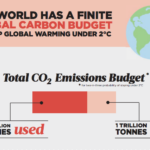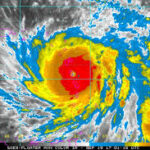On the morning of September 5, 2017, the National Hurricane Center (NHC) declared Hurricane Irma to be the first Category 5 hurricane to form east of the Leeward Islands, with maximum sustained winds of 175 mph and even stronger gusts. By the evening on that day, Irma had strengthened further, with maximum sustained winds of 185 mph (nearly 300 kph). In a statement closing with “May God protect us all,” officials on the Leeward Islands urgently warned the public to seek protection from Irma’s “onslaught.”
Within 36 hours of the NHC’s dire September 5 announcement, Irma had reduced the island of Barbuda to “rubble” and had obliterated St. Martin and St. Bart’s, provoking fears in St. Martin of a ‘civil war‘ for survival. Irma then showed “no mercy” to Anguilla and wreaked “absolute devastation” on the U.S. Virgin Islands, leaving “forests wiped out as far as the eye can see.”
By September 6, meteorologists were warning that Miami was increasingly likely to sustain a direct hit from Irma. The next day, I decided to go to Miami.
This admittedly unusual decision was precipitated in no small part by an interview I had done for The Real News Network on September 6. In that interview, renowned climate scientist Michael Mann explained the clear links between climate change and increasingly devastating extreme weather events like Hurricane Irma and Harvey, which only days earlier had inundated America’s fourth most populous city with the most extreme rainfall in United States history.
By the time that Harvey struck, it had become abundantly clear that the front-line of climate change is creeping inexorably toward the developed world, which has done far more to cause the climate crisis than those who suffer from it the most – the masses of poor who live in the developing world. Irma thus had the makings of a world historical event – a moment in which the most dire consequences of Western profligacy were visited upon the West itself, prompting rich nations possessing the means to solve our global climate emergency to awaken, finally, to the impending disaster.
Before departing for Miami on the morning of September 8, I reserved a hotel room on Miami Beach, expecting to have a front-row view of Irma’s arrival on the mainland. Within minutes of my making that reservation, Miami-Dade County Mayor Carlos Gimenez issued a mandatory evacuation order for Miami Beach and other coastal areas in Miami-Dade County. After considerable searching, I then found a second hotel in downtown Miami, but Mayor Gimenez quickly expanded his mandatory evacuation order to include the part of downtown Miami in which my plan B hotel was situated.
By that point, there was almost no hotel availability in all of South Florida: the decreasing supply of un-evacuated hotels had been overwhelmed by Floridians who were complying with the expanding evacuation orders. After yet more searching, the best hotel option I could find was situated two miles south of Fort Lauderdale airport and five miles from the southwest coast of Florida.
I arrived in Miami at 10 a.m. ET on Friday, September 8.
What follows is a timeline of my weekend with Irma, accompanied by the most striking photographs and videos from this remarkable weekend.
September 8, 10:15 a.m. ET: As I disembarked from my plane and walked past departure lounges at Miami International Airport, I saw crowds of anxious travellers waiting to board the last flights out of Miami before the scheduled closure of the airport later that day. In contrast to the jam-packed departure lounges, the ‘Miami Mover’, a conveyor belt which moves arriving passengers to the airport’s rental car centre, was eerily deserted.
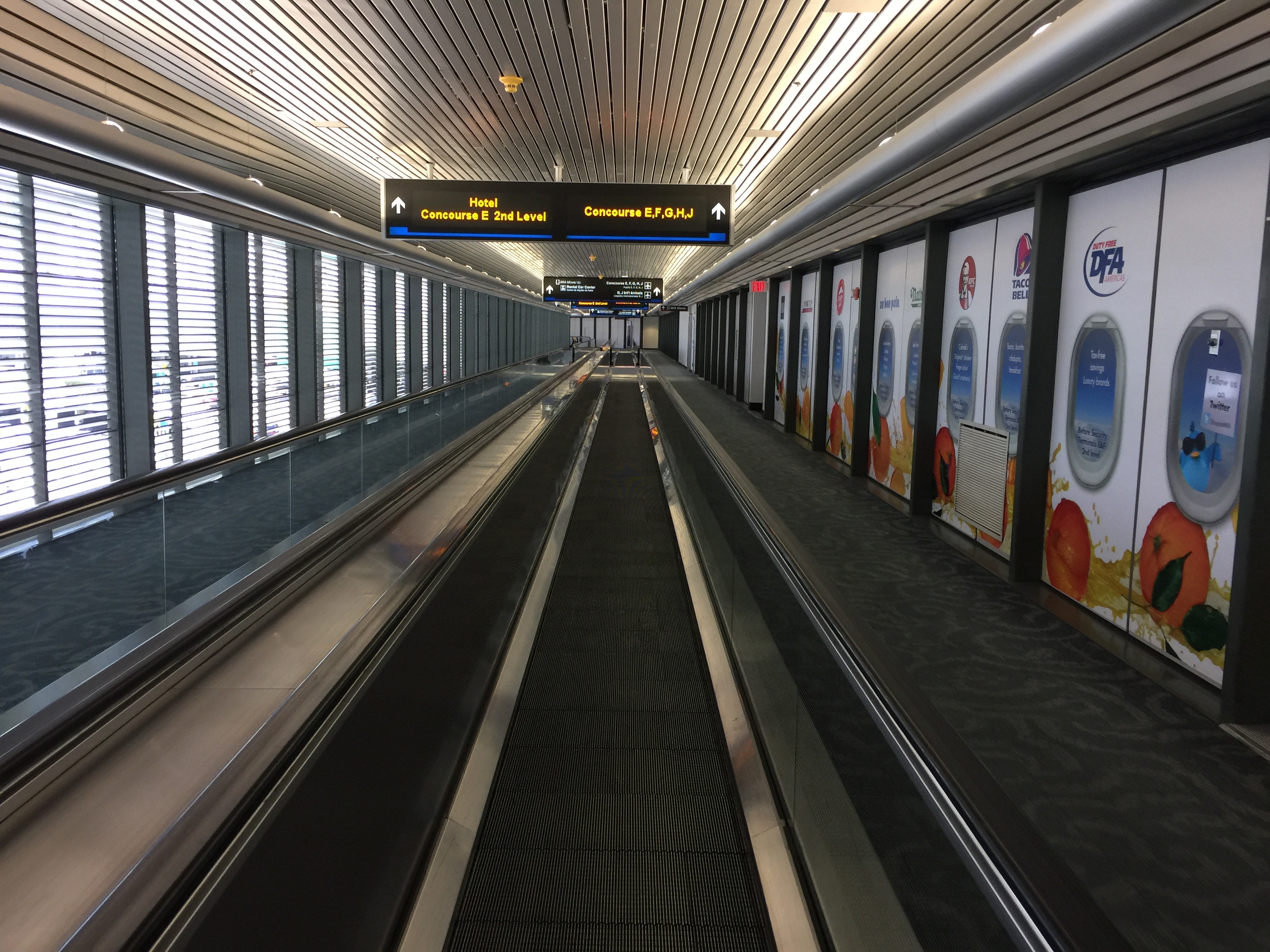
September 8, 11:30 a.m. ET: After renting a vehicle at Miami’s airport, I drove immediately to Miami Beach, whose residents had been ordered to evacuate. In the late morning of a hot and sunny Friday, Miami Beach was virtually deserted, and many of its homes and businesses were boarded up.
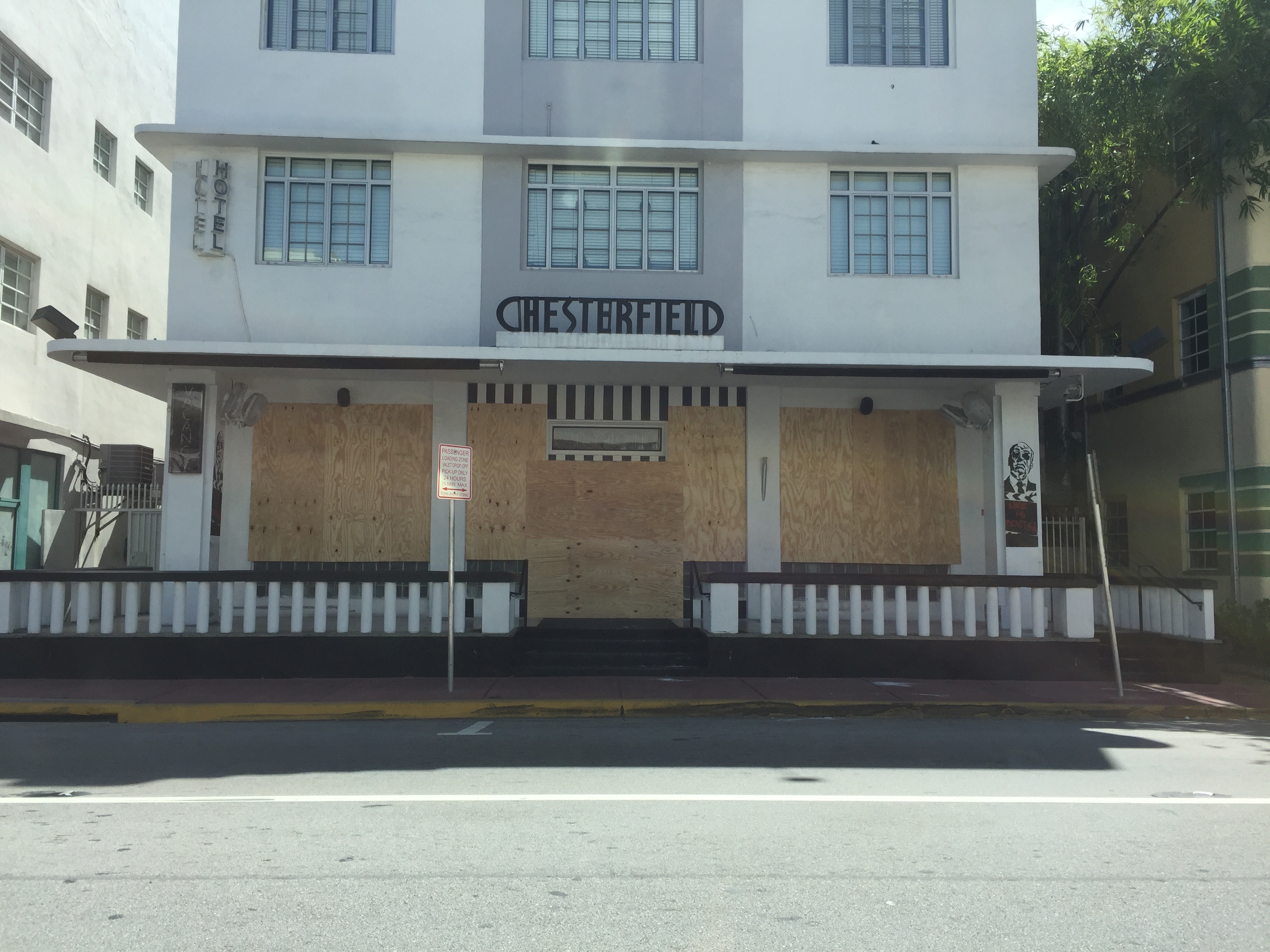

September 8, 12:00 p.m. to 11:00 p.m. ET: After completing my tour of Miami Beach, I drove to Fort Lauderdale airport and checked into my hotel. I then searched for a restaurant to have a late lunch. Almost every shop in the vicinity of my hotel was boarded up in preparation for Irma’s arrival.

The only open dining establishment that I could find was Miller’s Ale House at the Oakwood Plaza. After I took my seat at the bar, the bartender announced that she was holding a “hurricane party.” She then saluted every patron who stood up to leave with the words “see you on the other side!”
After lunch, I drove to Hollywood North Beach Park and found it to be as deserted as Miami Beach.
[wpvideo Tl6w522m]On my way back from Hollywood North Beach, I found an open grocery store and purchased sufficient provisions for three days. I then returned to my hotel room and filled my refrigerator with groceries.
I turned on the television to see what the local media were saying about the path that Irma was now expected to take. The local affiliates of all of the major networks were offering 24-hour, commercial-free coverage of the storm. Every station’s coverage was dominated by the station’s chief meteorologist.
As I flipped from one station to the next, it soon became apparent that the dean of local meteorologists is John Morales of NBC 6. Morales is not shy of reminding his viewers that he is the longest tenured broadcast meteorologist in South Florida, serving as a “reassuring presence” for nearly 25 years.
Throughout the evening, Morales explained that, after pummelling Puerto Rico, the Dominican Republic and Haiti, Irma had become bogged down over the northern coast of Cuba. There, Irma had landed as as a deadly Category 5 hurricane. As a result of Irma’s interaction with mountainous regions of Cuba, the prospect of Irma weakening before striking south Florida had increased.
Moreover, it was becoming increasingly likely that the eye of this monster would not strike the southeast coast of Florida, but that it would travel up Florida’s southwest coast, potentially striking Tampa. Before Irma’s arrival, Tampa was last struck by a major hurricane in 1921, when it had a population of 10,000. Less than 100 years later, Tampa’s population had soared to 3 million. It thus appeared that Florida’s obsession with rapid development would be put to a serious test.
Whatever path Irma would ultimately take, it was by now virtually certain that Irma would deliver catastrophic devastation to the Florida Keys. By late Friday night, however, there remained considerable uncertainty as to which part of mainland Florida was at greatest risk.
September 9, 10:00 a.m. to ET:
When I awoke on Saturday morning, I headed down to the lobby of my hotel to grab some breakfast. There were children and pets everywhere. Many families from south Florida coastal communities had sought refuge at this hotel. One of the hotel guests, a retiree with a thick New York accent who had lived in Florida for many years, struck up a conversation with me over breakfast. He confided to me that he had calmly endured many hurricanes over the years, but that Irma terrified him so much that it had made him cry.
After breakfast, I drove back to Hollywood North Beach Park to see how conditions had changed. The sun was now concealed by a thick layer of dark clouds. Winds were noticeably brisker, and the waters had begun to churn. Seaweed blanketed the beach.

After I returned to my hotel later that morning, Barbara Sharief, the mayor of Broward Country, announced that she would impose a county-wide curfew at 4 p.m. that day. I therefore decided to return to Hollywood North Park Beach to do a live report on Irma for The Real News. This is a recording of that report:
[wpvideo 1Xaq70HR]When I arrived at the beach at 3:00 pm, the waves had become menacing and the wind so powerful that it whipped sand into my face, forcing me to don sunglasses to protect my eyes.
[wpvideo uqjUAzTr]After completing my report for the Real News, I stood on the boardwalk to take it all in before the curfew went into effect.
A woman with a Quebecois accent then approached me and asked me where I was from. When I told her that I was from Canada, she introduced herself as Stephanie Marin of the Canadian Press. Stephanie explained that she was looking for Canadians on the beach to interview about Irma. While I explained to Stephanie that I was a reporter for The Real News, a third reporter from Telemundo approached us with a cameraman at her side. The Telemundo reporter then thrust a microphone in Stephanie’s face and began to ask her questions about Irma.
As the curfew approached, the only people on the beach were reporters so desperate for content that they were interviewing each other.
September 9, 6:00 p.m. to 11:00 p.m. ET:
Minutes before Broward County’s curfew went into effect, I returned to my hotel room and turned on the television.
By that point, the outer bands of hurricane Irma had begun to pass over south Florida. Between the outer bands, there were pockets of clear sky, but within the bands were large pockets of fast-moving, violent thunderstorms. That evening, the weather changed with breathtaking speed. At times, conditions outside deteriorated dramatically within a matter of minutes, only to be followed by a peaceful calm.
John Morales was on the air again. During my weekend with Irma, Morales was ubiquitous. This was the moment when Florida’s TV meteorologists get to play the leading role, and Morales had no intention of relinquishing the microphone.
At 6:35 p.m., Morales announced a tornado warning. Within minutes of his announcement, my iPhone made a sharp, grating noise that I had never heard before. It was a tornado alert. Morales announced another tornado alert, and then another. My iPhone sounded again. Morales urged viewers to get away from their windows and to retreat into their closets. Soon Morales became breathless. He proclaimed in amazement that he had never witnessed so many tornado alerts in so little time.

Against my better judgment, I ventured briefly into the hotel parking lot to see if I could spot a tornado, but all that I found there were five ducklings seeking shelter at their mother’s side.

When I returned to my hotel room, NBC 6 aired footage of a funnel cloud approaching Fort Lauderdale. Remarkably, the funnel cloud did not do significant damage to any populated areas. The next day, I learned from a hotel security guard that a tornado had passed over the artificial lake situated directly beside our hotel, but I myself never saw it.
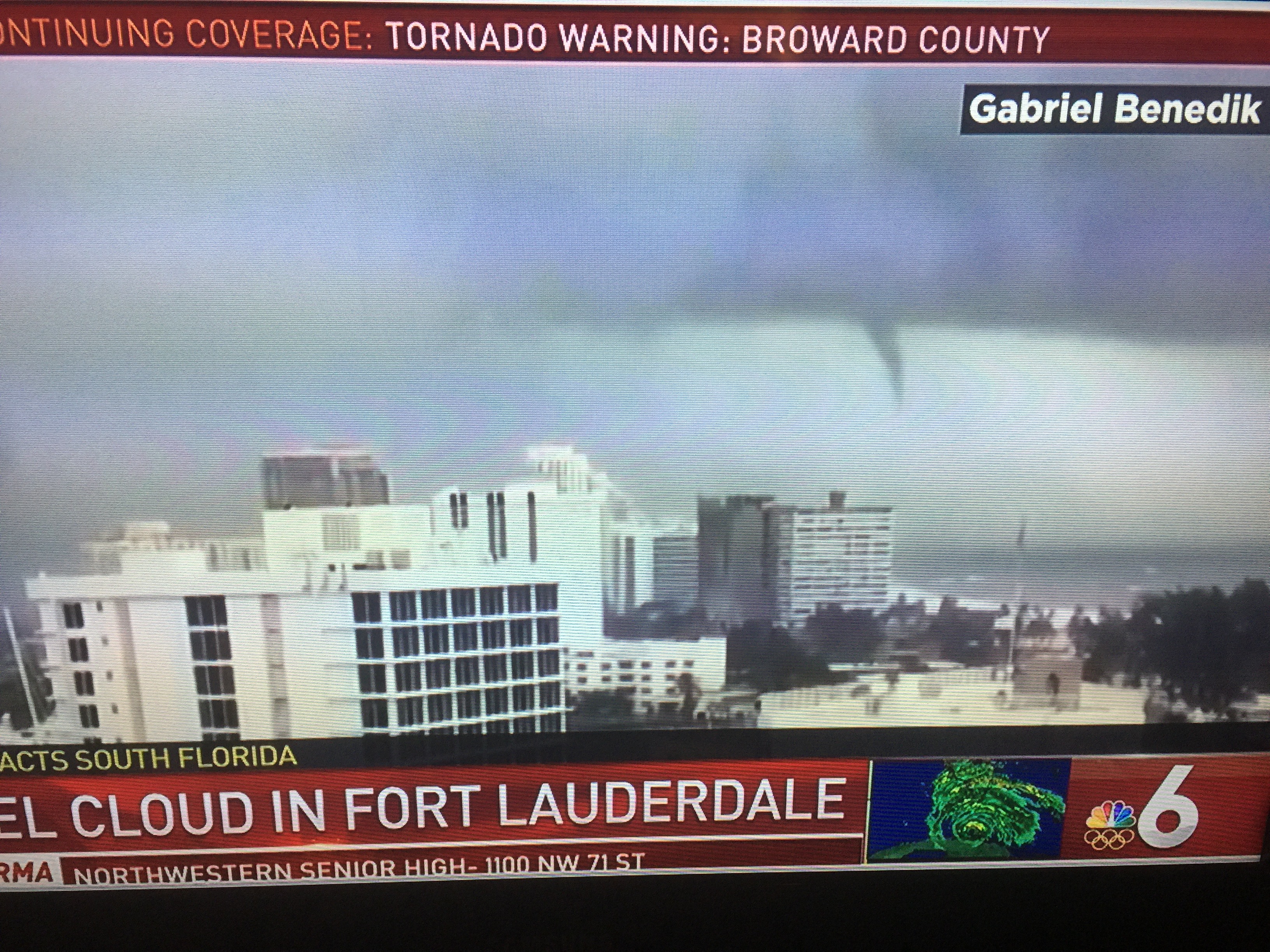
At around 9:00 p.m., the area in which my hotel was situated suffered a power outage. From that moment to the time that I left my hotel on the morning of September 11, there was no power in the area of my hotel. Late on Saturday night, frequent flashes of lightning outside of my window illuminated the night sky.
[wpvideo goWLPtWM]After the power went out at my hotel, my cell phone service became limited, but occasionally I was able to access the website of the Miami Herald, which had lifted its pay-wall for the duration of the storm. The Herald advised that Irma’s eye-wall had now departed the northern coast of Cuba as a weakened Category 3 hurricane and was approaching the Florida keys. Before arriving there, it was expected to re-strengthen to a Category 4 hurricane and then to travel up the southwest coast of Florida toward Tampa. The Herald cautioned, however, that Miami-Dade and Broward counties lay in the path of the “dirty part of the storm.” This was the hurricane’s northeast quadrant, which typically contained the strongest winds beyond the eye-wall. According to the Herald, Miami-Dade and Broward counties were expected to experience tropical storm force winds at some point late Sunday morning, and hurricane force winds from the afternoon until the late evening.
At around 11 pm on Saturday, the weather outside my hotel room returned to an eerie calm, and I feel asleep.
September 10, the day that Irma made landfall in South Florida:
When I awoke the next morning, my hotel room was hot and dank. Without air conditioning, the heat and humidity of a late south Florida summer had now penetrated into the hotel.
I descended to the lobby to grab some breakfast. An elderly man sat at my table and introduced himself to me as a retired security officer of the U.S. Department of Justice (DoJ). (To protect his privacy, I will refer to him as “John”.)
John now lived in Tampa and had come to the hotel to seek shelter from Irma. He took out his wallet and proudly showed me his now expired DoJ identification card. John explained that he had joined the DoJ during the tenure of former Attorney General Edwin Meese, which began in 1985, during the presidency of Ronald Reagan. John acknowledged that Meese had become embroiled in ethics scandals, but he talked about Meese with affection bordering on reverence.
John’s feelings about Obama Attorney General Eric Holder were entirely different. John despised Eric Holder and talked derisively about a conversation he had overheard in which Holder allegedly said “isn’t it ironic that my father was the biggest drug dealer in Chicago and I am now the Attorney General of the United States?” As I wondered why the purported sins of Holder’s father might render Holder unfit for the office of Attorney General, John proclaimed himself to be a Trump supporter. He asked me how I felt about Trump. I told him that my opinion about Trump was “very negative.” John scowled. He then asked me what I thought about Hillary Clinton, to which I responded “also very negative.” John smiled. “So which candidate for the presidency would you have supported if you were American?”, he asked. “Bernie Sanders,” I answered. John’s reaction to this answer was instructive. He seemed intrigued by Sanders, but was worried about Sanders’ commitment to socialism. “Actually,” I explained, “Sanders declares himself to be a ‘democratic socialist’, and his platform was relatively moderate.” After explaining to John some of the main elements of Sanders’ platform, I cautioned him that Trump had already demonstrated that his platform was a ruse. I focused on Trump’s promise to withdraw U.S. military forces from America’s disastrous wars in Afghanistan and Iraq, which Trump has brazenly violated. John acknowledged that he was disappointed in that aspect of Trump’s presidency, but he insisted that “Trump is the only good leader we got.” At that point, I wished John well and headed back upstairs.
On the 3rd floor of my 6-story hotel, where my hotel room was situated, there were two good vantage points from which to watch Hurricane Irma unfold. At either end of my hallway, there was a balcony framed by thick, concrete walls and an iron gate. I was also able to watch the hurricane from ground level at the base of the main stairwell in the hotel. The area immediately outside the exit from that stairwell was protected from the wind by the exterior walls of the hotel lobby, which jutted out to the left of the stairwell exit.
At 9:25 a.m., I descended to the base of the stairwell and opened the exit door. There I saw winds so powerful that a torrential downpour was flowing horizontally.
[wpvideo tAd9wJwf]At 11:25 a.m., I ventured onto one of the 3rd floor balconies and immediately saw a powerful wind gust tear a leaf sheath off of a nearby palm tree.
[wpvideo yKwVjkUB]By 2:51 p.m. on Sunday, the winds outside of our hotel were now of hurricane force. Many wind gusts were well in excess of 100 mph. The wind was so powerful that, in a parking lot next to my hotel, the wind tore a stop sign from its metal post.
[wpvideo lhZdG7mt]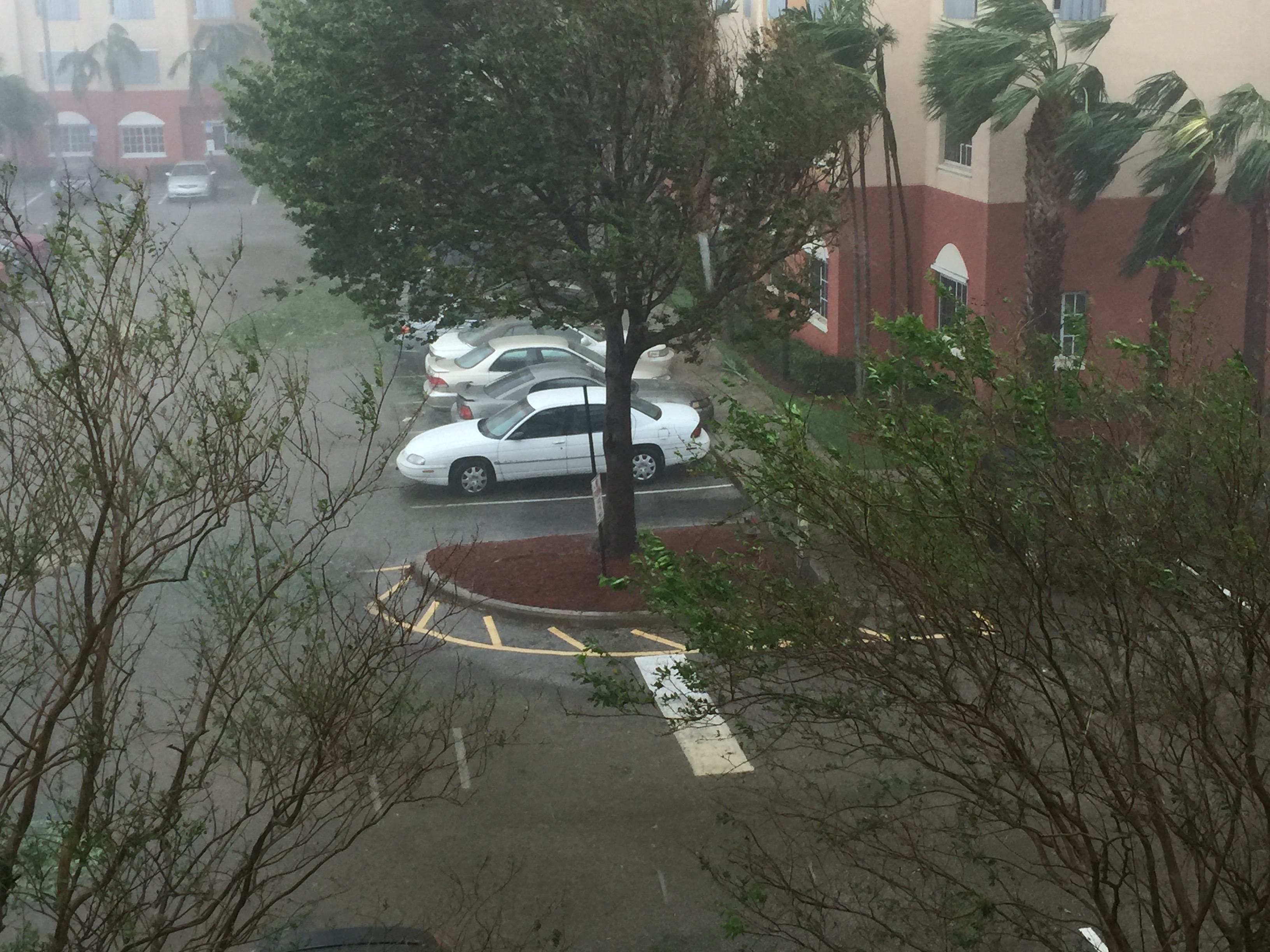
Employees of the hotel had by then laid glowing sticks onto the floors of the hotel’s hallways to guide guests through the darkness.

At 4:20 p.m., I went out onto the balcony overlooking our hotel’s parking lot and discovered that a large tree had been uprooted by the wind. The tree remained upright thanks only to the power lines overhead. My vehicle was parked 10 meters from the uprooted tree but I elected to leave the vehicle there because the power lines might snap and begin flailing in the wind. Amazingly, those power lines never snapped.
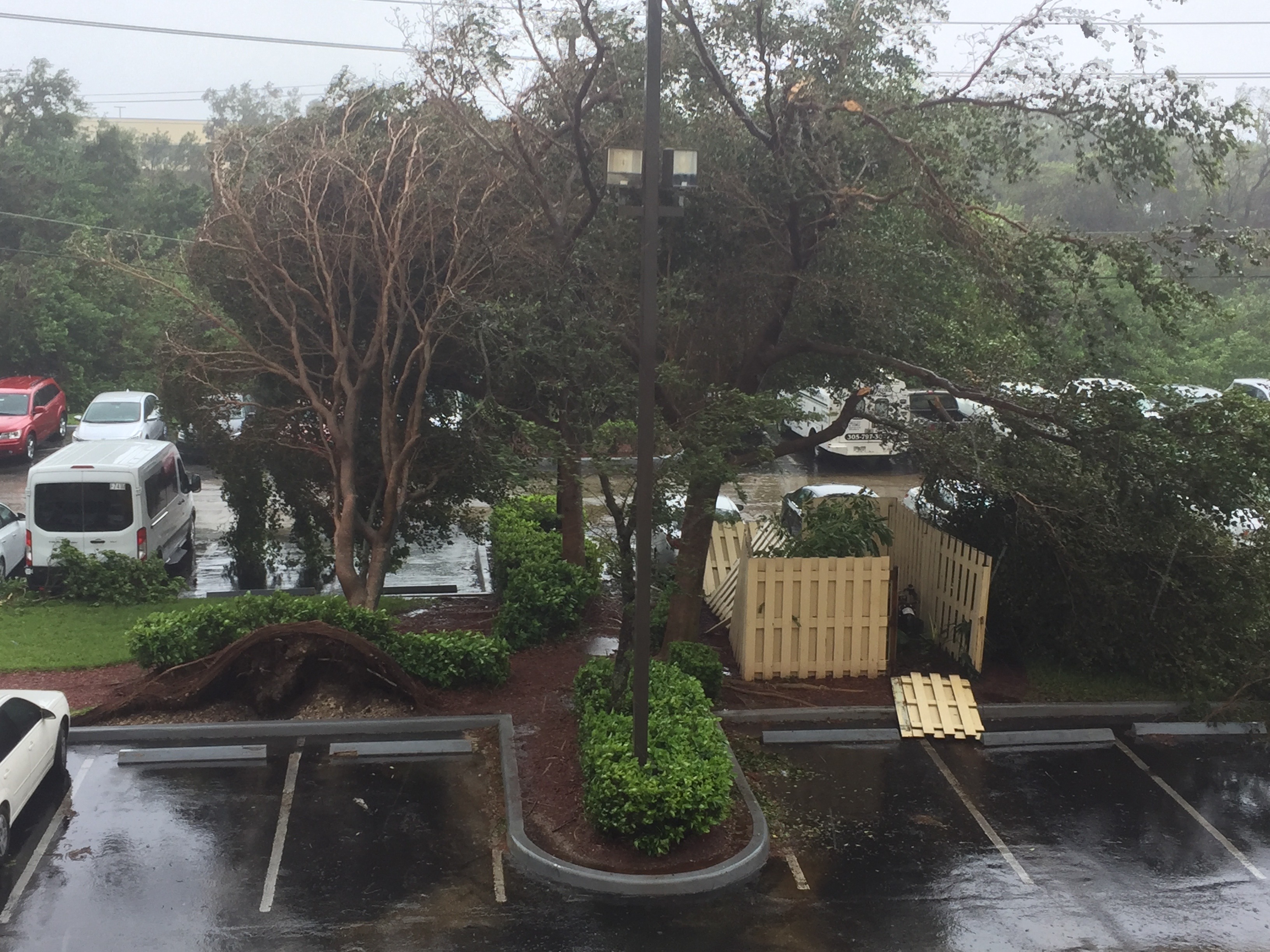
By 6:15 p.m. on Sunday, the worst of the storm had passed. From one of the 3rd floor balconies, I discovered that the 5 duckings and their mother had survived Irma’s worst winds.

By 9:00 p.m., the sun had set and the hotel had been pitched into darkness again. The hotel rooms had become intolerably hot and humid. The winds remained brisk but were no longer of dangerous strength. The torrential rain had weakened to a drizzle. I therefore decided to drive to downtown Miami, about 20 miles away, to survey the damage there.
During my drive to downtown Miami, I found Interstate 95 to be deserted, except for the occasional emergency vehicle. Downtown Miami itself was strewn with debris from shredded and uprooted trees. I also saw some broken windows and significant flooding. Although the Miami Herald was reporting that hurricane force winds had destroyed two large cranes in downtown Miami, I saw no major damage to infrastructure in the city center.
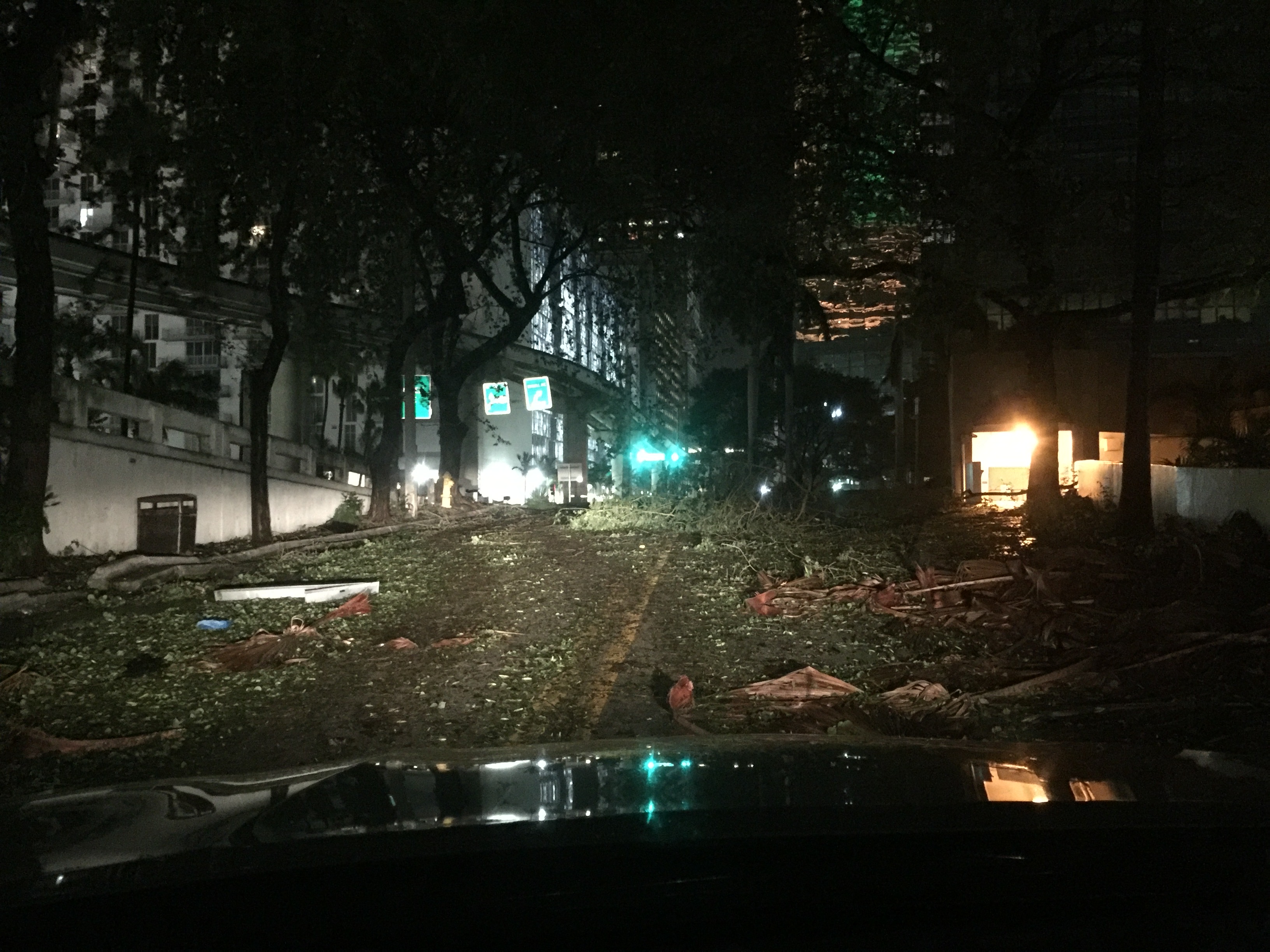




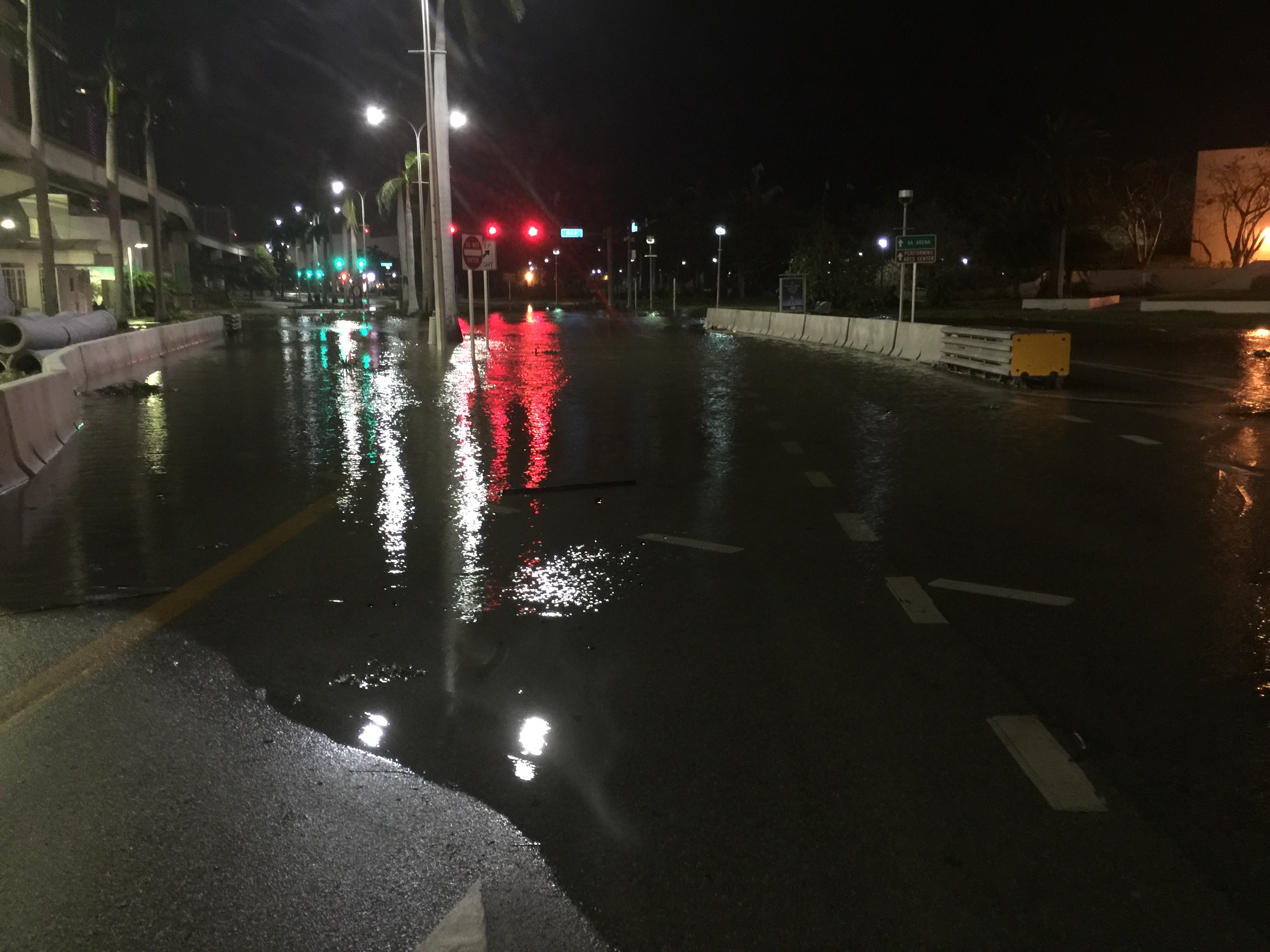
The Day After: September 11, 2017
By the morning of Monday, September 11, Miami’s skies had cleared, but the state was suffering from power outages of staggering dimensions.
Shortly after my arrival in Miami on Friday, I had watched a televised press conference conducted by Rob Gold, the smooth-talking spokesperson for a major utility company, Florida Power and Light (FPL). Gold boasted that FPL had “invested heavily” in enhancing the resiliency of Florida’s electricity grid. Gold claimed that “we are probably more ready than we have been for any other storm.”
At the time of Gold’s press conference, Irma was a Category 4 hurricane that had been projected to make a direct hit on Miami-Dade county, the most populous part of the state. But that direct hit never came, and when Irma made landfall on the southwest coast of mainland Florida, it was only a Category 2 hurricane. Later, despite fears of a calamity in low-lying Tampa, Irma left Tampa “largely unscathed.”
Despite Gold’s assurances and a weaker-than-expected storm, more than 60% of Florida’s homes and businesses were without power on the morning of September 11. Exacerbating matters was an almost total lack of gasoline for a state that is obsessed with cars. The scarcity of gasoline persisted days after Hurricane Irma struck. The scarcity of electricity and gas had almost completely paralyzed the state.
Nonetheless, with the exception of the extremely vulnerable and lightly populated Florida Keys, damage to Florida’s infrastructure was modest compared to the near-annihilation of Barbuda, St. Martin and other Caribbean islands. This became clearer as I surveyed the damage to Broward and Miami-Dade Counties in daylight on September 11. Although I encountered light flooding and saw extensive damage to vegetation, almost all buildings in the area were essentially in tact.

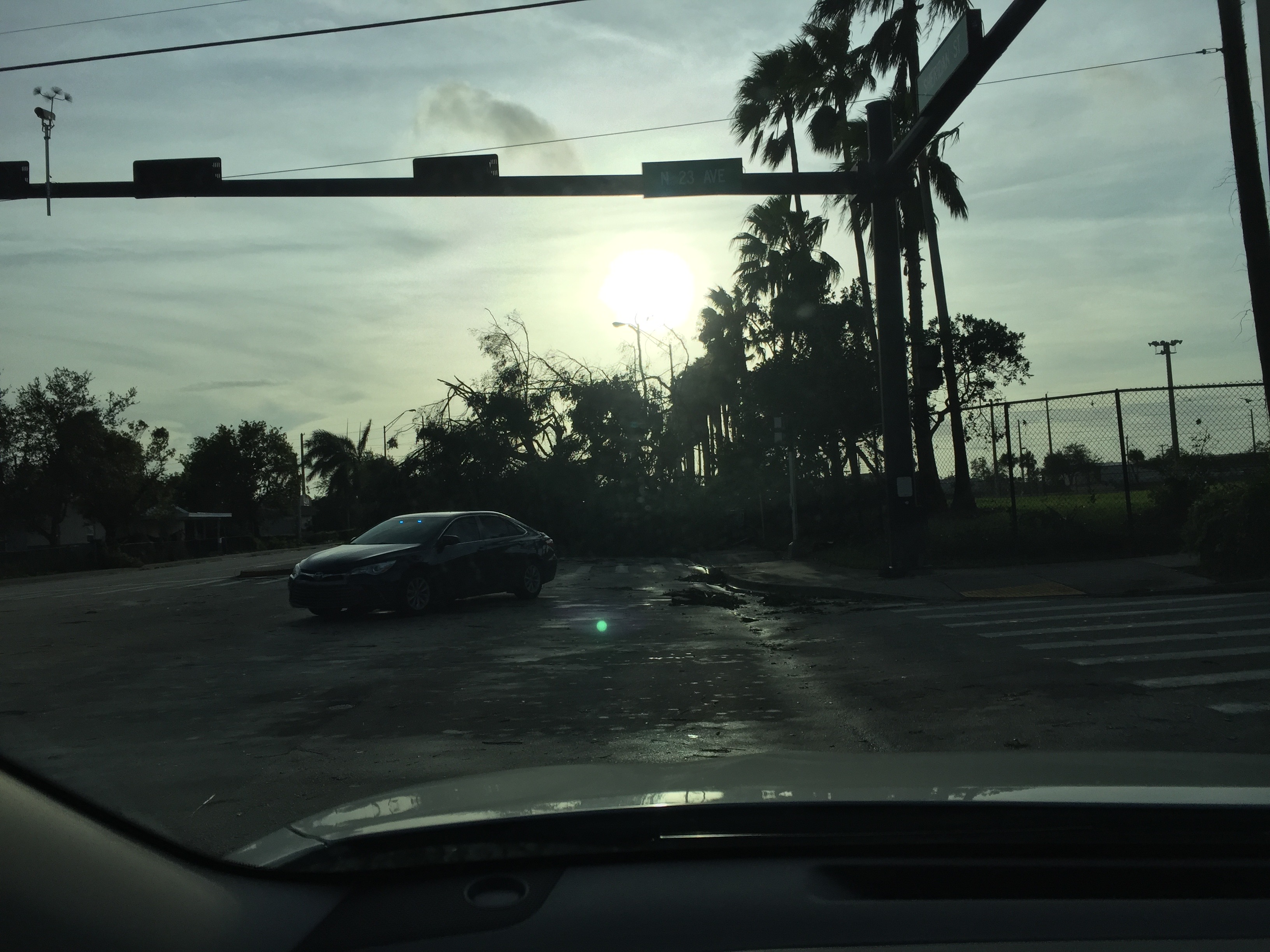


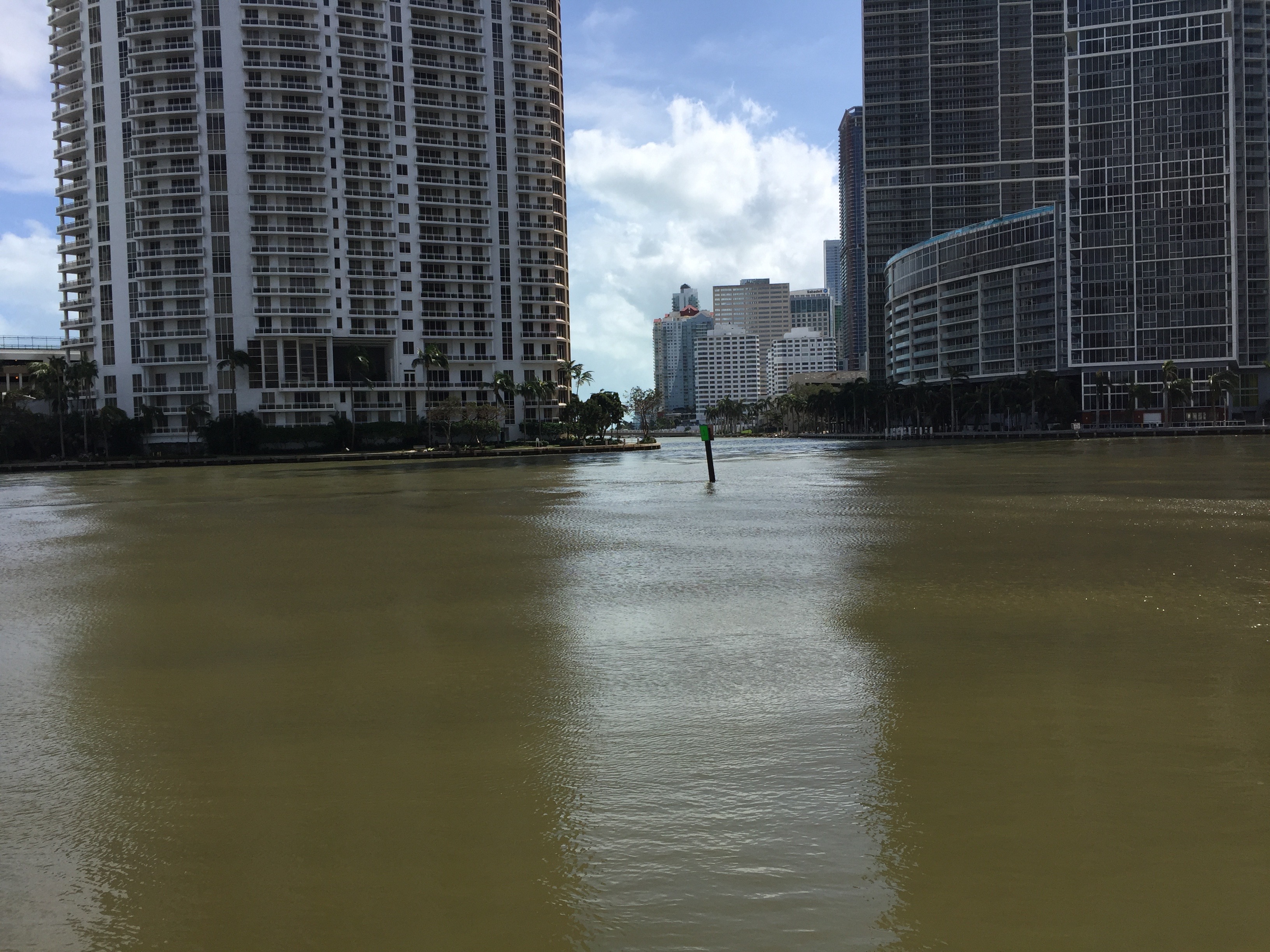
In front of the Versace Mansion on Ocean Drive in Miami Beach, hurricane force winds had snapped a palm tree like a twig, but the mansion itself appeared to have sustained no damage.
After surveying Versace Mansion, I drove down Ocean Drive and saw many damaged or uprooted trees but no significant damage to buildings in what is almost certainly the most vulnerable part of Miami.

Postscript
In the end, Hurricane Irma may well be counted as one of the costliest natural disasters in United States history, but there is no reason to believe that Irma and Harvey have caused a meaningful improvement in the Republican elite’s attitude toward the climate crisis.
For the past several weeks, Floridians have been bombarded with press conferences by Republican Governor Rick Scott. Wearing a baseball cap that evoked memories of ex-NY Mayor Rudolph Giuliani managing the 9/11 aftermath, Scott has shamelessly promoted his crisis-management skills. If I had a dollar for every time Scott said “we can rebuild your home, but we cannot rebuild your life,” I’d be richer than Bill Gates. It’s fair to assume Floridians already knew that Rick Scott lacks the power to resurrect the dead. Equally tedious were Scott’s constant references to his love of his family, which did nothing to reassure Floridians about the gigantic hurricane threatening theirs.
Scott’s performance in these press conferences raises an uncomfortable question: if Rick Scott cares so deeply about his children, why is he impeding action to address the climate crisis in the American state that is most threatened by it?
After Rick Scott took office in 2011, employees of Florida’s Department of Environmental Protection were ordered not to use the terms ‘climate change,’ ‘global warming’ or ‘sustainability.’
Four years later, Florida joined 23 other states in suing the United States government over a plan to reduce carbon emissions nationally, claiming the law would increase electric rates. Yet Scott’s purported concern for electricity rates cannot be reconciled with his hostility to solar energy in Florida, which ranks third in the nation for solar potential but 18th for total installed solar power capacity.
As The Intercept reported recently, Scott even cut funding for Florida’s water management districts in 2011, leading to staff reductions and less funding for ecosystem restoration projects. Around the same time, Scott signed into law a repeal of the state’s 1985 growth management legislation, leading to a surge in development. As Hurricane Harvey demonstrated, however, development from depleted wetlands can exacerbate the effects of storms.
From the time he became Governor of Florida, Scott has consistently whistled the tune of those who have paid the piper. Florida’s four biggest utilities – Duke Energy, Gulf Power, FPL and Tampa Electric – have obstructed the development of solar energy by throwing millions of dollars at Florida’s political campaigns, including well over $1 million showered on Rick Scott.
So has the epic destruction caused by Hurricanes Harvey and Irma chastened Rick Scott? Has the devastation in Texas and the Caribbean persuaded Scott to emerge from his dark intellectual cave, his alternate reality?
Even now, Scott refuses to acknowledge the reality of climate change.
Meanwhile, Donald Trump, the Denialist-in-Chief, continues to dismiss questions about climate change with simplistic assertions like “we’ve had bigger storms.” In what sense were past storms ‘bigger’? Harvey broke the record for rainfall from a tropical cyclone in the United States, dropping more than 50 inches of rain on parts of Texas and Louisiana in a matter of days. Irma was the first Category 5 hurricane to form east of the Leeward Islands and remained a Category 5 hurricane for three days and three hours, the second-longest for any storm on record.
All indications are that the Republican elite remains in denial. But nature will not wait for the GOP to come to its senses.










